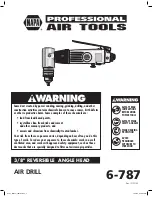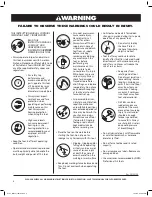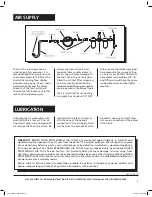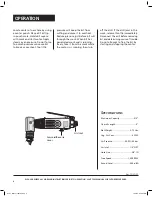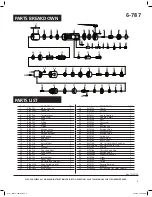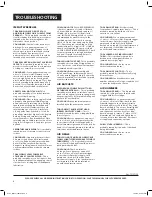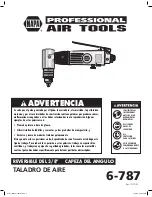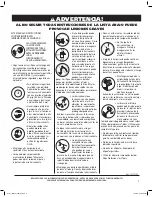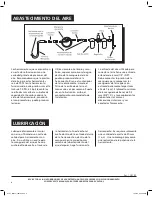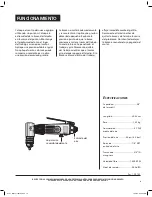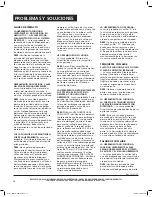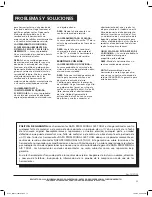
Rev. 10/07/05
IMPACT WRENCHES
TOOL RUNS SLOWLY OR NOT AT ALL
AND/OR AIR FLOWS ONLY SLIGHTLY FROM
EXHAUST —
This is probably caused by: air
flow blocked by dirt build-up; motor parts
jammed with dirt; power regulator has
vibrated to closed position.
YOU SHOULD:
Check air inlet strainer for
blockage. Pour a generous amount of
air tool oil into air inlet. Operate tool in
short bursts, in both forward and reverse
motion. Repeat if necessary. If tool
performance is not improved, it should be
serviced at an authorized service center.
TOOL WILL NOT RUN, EXHAUST AIR FLOWS
FREELY.
This is probably caused by one or
more motor vanes stuck due to accumulation
of sludge or varnish ; motor rusted.
YOU SHOULD:
Pour a generous amount of
air tool oil into air inlet. Operate tool in
short bursts, in both forward and reverse
motion. Lightly tap motor housing with
plastic mallet. Detach air supply. Try to free
motor by turning drive shank manually, if
possible. If tool remains jammed, it should
be serviced at authorized service center.
SOCKETS WILL NOT STAY ON.
This is
probably caused by: worn socket retainer
ring or soft back-up ring.
YOU SHOULD:
Wear safety goggles. Detach
air supply. Using external retaining ring
pliers, remove old retaining ring. Holding
square drive with appropriate open-end
wrench, use small screwdriver to pry old
retainer ring out of groove. Always pry
off ring away from your body - it can be
propelled outward at high velocity. Replace
back-up O-ring and retainer ring with
correct new parts. (See breakdown). Place
retaining ring on table, press tool anvil into
ring in a rocking motion. Snap into groove
by hand.
PREMATURE ANVIL WEAR.
This is probably
caused by: use of chrome sockets or worn
sockets.
YOU SHOULD:
Stop using chrome sockets.
Chrome sockets have a hard surface and
a soft core. Drive hole becomes rounded -
but will still be very hard. Besides the
danger of splitting, wrench anvils will wear
out prematurely when used with chrome
sockets.
TOOL SLOWLY LOSES POWER BUT
STILL RUNS AT FULL FREE SPEED.
This is
probably caused by: worn clutch parts, due
to inadequate lubrication; engaging cam of
clutch worn or sticking due to inadequate
lubrication.
YOU SHOULD:
FOR OIL LUBED WRENCHES
- check for presence of clutch oil (where
oil is specified for clutch) and remove oil
fill plug; tilt to drain all oil from clutch
case; refill with 30 weight SAE oil or that
recommended by manufacturer, in the
specified amount. Also check for excess
clutch oil. Clutch cases need only be filled
50%. Overfilling can cause drag on high
speed clutch parts. A typical 1/2" oil-lubed
wrench only requires 1/2 ounce of clutch
oil. FOR GREASE LUBED WRENCHES - Check
for excess grease by rotating drive shank
by hand. It should turn freely. Excess is
usually expelled automatically.
TOOL WILL NOT SHUT OFF.
This is probably
caused by: throttle valve O-ring broken or
out of position or throttle valve stem bent
or jammed with dirt particles.
YOU SHOULD:
Remove assembly and
install new O-ring. Lubricate with air tool
oil and operate trigger briskly. If operation
cannot be restored,tool should be serviced
at authorized service center.
AIR RATCHETS
MOTOR RUNS. SPINDLE DOESN'T TURN,
OR TURNS ERRATICALLY —
This is probably
caused by: worn teeth on ratchet or pawl;
weak or broken pawl pressure spring; weak
drag springs fail to hold spindle while pawl
advance for another bite.
YOU SHOULD:
have replacement parts
installed by authorized service center.
TOOL DOESN’T RUN, RATCHET HEAD
INDEXES CRISPLY BY HAND—
This is
probably caused by: dirt or sludge build-up
in motor parts.
YOU SHOULD:
Pour a generous amount of
air tool oil into air inlet. Operate throttle
in short bursts. With socket engaged on
bolt, alternately tighten and loosen bolt by
hand. If tool remains jammed, it should be
serviced at authorized service center.
AIR DRILLS
TOOL WILL NOT RUN, RUNS SLOWLY, AIR
FLOWS SLIGHTLY FROM EXHAUST, SPINDLE
TURNS FREELY —
This is probably caused
by: air flow blocked by dirt build-up; motor
parts jammed with dirt.
YOU SHOULD:
Check air inlet for
blockage. Pour a generous amount of
air tool oil into air inlet. Operate trigger
in short bursts Detach air supply; turn
empty and closed drill chuck by hand.
Reconnect air supply. If tool performance is
not improved, it should be serviced at
an authorized service center.
TOOL WILL NOT RUN.
Air flows freely
from exhaust. spindle turns freely — This is
probably caused by: Build up of dirt or
varnish on rotor vanes.
YOU SHOULD:
Pour a generous amount
of air tool oil into air inlet. Operate trigger
in short bursts. Detach air supply; turn
empty and closed drill chuck by hand.
Reconnect air supply. If tool performance is
not improved, it should be serviced at
an authorized service center.
TOOL LOCKED UP, SPINDLE WILL NOT
TURN —
This is probably caused by: a
broken motor vane; gears broken or
jammed by foreign object.
YOU SHOULD:
Send the tool to an
authorized service center.
TOOL WILL NOT SHUT OFF —
This is
probably caused by: throttle valve O-ring
blown off seat.
YOU SHOULD:
See breakdown for part
number and replace O-ring or send the tool
to an authorized service center.
AIR HAMMERS
TOOL WILL NOT RUN —
This is probably
caused by: cycling valve or throttle valve
clogged with dirt or sludge.
YOU SHOULD:
Pour a generous amount
of air tool oil into air inlet; check for dirt.
Operate trigger in short bursts (chisel in
place and against solid surface). If not free,
detach air supply. Tap nose or barrel lightly
with plastic mallet, reconnect air supply,
and repeat above steps. If still not free,
detach air supply, insert a 6" piece of 1/8"
diameter rod in nozzle and lightly tap to
loosen piston in rear direction. Reconnect
air supply and repeat above steps.
CHISEL STUCK IN NOZZLE—
This is
probably caused by: the end of the shank
being disformed.
YOU SHOULD:
Send the tool to an
authorized service center.
TROUBLESHOOTING
PLEASE REVIEW ALL WARNING INSTRUCTIONS PRIOR TO OPERATION. SAVE THIS MANUAL FOR FUTURE REFERENCE.
6
6-787_Manual_100705.indd 6
10/7/05 8:16:27 AM

